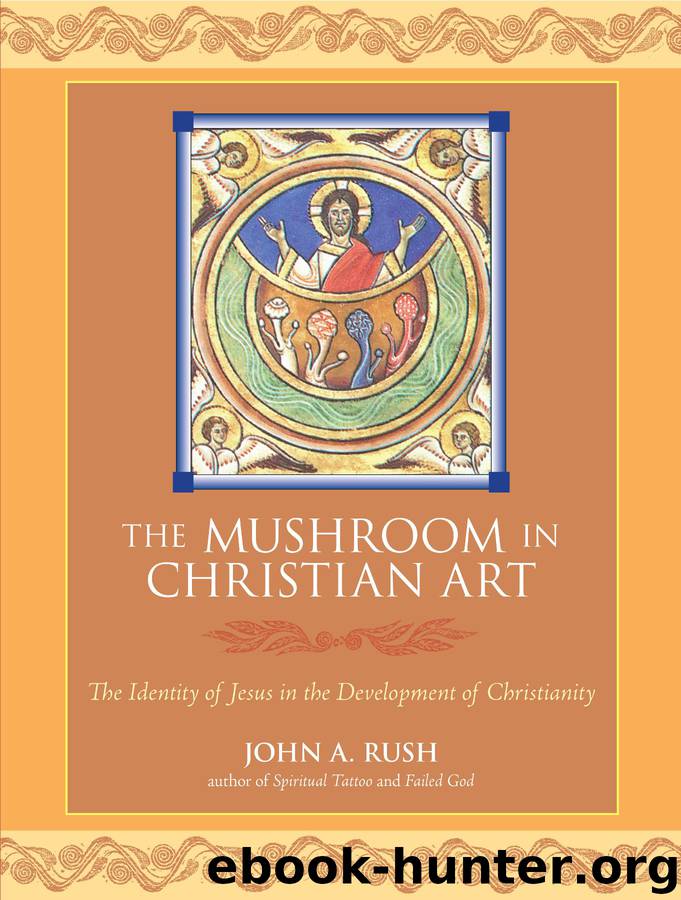The Mushroom in Christian Art by John A. Rush

Author:John A. Rush
Language: eng
Format: epub
Tags: ART015000 Art / History / General
Publisher: North Atlantic Books
The Majesty of Christ, Abbey of Vézelay, Bourgogne, France (Plate 2: 30)
This cathedral was constructed between the ninth and eleventh centuries on a hilltop in Vézelay (north-central France). This is undoubtedly an ancient site most likely used by Paleolithic hunters to spot game. In any case, as the legend goes, once upon a time (c. 900 CE) a well-meaning monk called Baudillon obtained very special bones, relics if you will, of Mary Magdalene. This gets into the whole Da Vinci Code business, which falls to the wayside once you realize that Jesus was an experience and not a real living, breathing human being. Mary Magdalene, on the other side, might have been a real person. If she was a real person, she might indeed have been very influential in the second stage of that original group, the core who stuck it out after their guru (the Baptist?) left the scene. In fact, I have wondered if the priestess in Plate 2: 1 is a depiction of Mary Magdalene, with the male apprentice balancing the scene. And then I wondered, “Could that be the son of Mary Magdalene?” From what we have been told about the Essenes, celibacy was an ideal. The assumption is that whoever walked out of the desert (portrayed as John the Baptist) left of his own volition. Well, maybe. Perhaps he was asked to leave; perhaps he understood the way to God’s house had nothing whatsoever to do with sex or following divisive rules. It had to do with human decency.
As mentioned earlier, Monk Baudillon (c. 900 CE) had in his collection of relics the bones of Mary Magdalene, which were authenticated by papal decree. The behavior of collecting evidence of the story of Jesus includes relics as tangible proof that the story is true; anthropologists do the same thing but with a different purpose in mind. We are told this was touched off by Helena, mother of Constantine, who the Church claims sought after and found the very cross upon which Jesus was crucified, that device of transmutation that turned Jesus’s carnal flesh into spirit.
Abbatiale de Vézelay (Bourgogne, France) is a very important center for pilgrims, sort of a spiritual Disney Land, and pilgrims brought large amounts of money into the town coffers. In 1146 CE, Bernard of Clairvaux organized the Second Crusade at Vézelay; the Third Crusade departed from there as well. As a center for pilgrims, also known as tourists, you need attractions, statues, paintings, pretty flowers, views of the countryside, and bones. “Here are the bones of Mary Magdalene, the woman by His side while on the cross. Now you understand what you are fighting for!”
Relics (i.e., bones, capes, shrouds, and so on) contain power by virtue of the fact that they are thought to be in association with special people who, in most cases, obtained some sort of power or unusual capabilities from a deity (contagious magic). For example there is the story of St. Paul as told in The Golden Legend (de Voragine 1993, vol.
Download
This site does not store any files on its server. We only index and link to content provided by other sites. Please contact the content providers to delete copyright contents if any and email us, we'll remove relevant links or contents immediately.
Michelangelo And The Sistine Chapel by Andrew Graham-Dixon(1028)
Seven Secrets of Shiva by Devdutt Pattanaik(931)
Accounts and Images of Six Kannon in Japan by Sherry D. Fowler(928)
The Geometry of Love by Margaret Visser(921)
Saints, Shrines and Pilgrims by Roger Rosewell(897)
The Mushroom in Christian Art by John A. Rush(889)
Resurrecting Easter by John Dominic Crossan(873)
The Lost Painting by Jonathan Harr(868)
Buddhism Illuminated by San San May Jana Igunma(857)
THE FRESCO by The Fresco(853)
Ayala's Angel by Anthony Trollope(821)
Illuminated Manuscripts by Richard Hayman(821)
The Handbook of Tibetan Buddhist Symbols by Robert Beer(795)
Creating Personal Mandalas by Cassia Cogger(791)
Silence and Beauty by Makoto Fujimura(773)
Moon by the Window by Shodo Harada(747)
Dharma Delight by Rodney Alan Greenblat(735)
Art From The Sacred To The Profane: East by Schuon Frithjof(734)
Saint Paul by Pier Paolo Pasolini(733)
